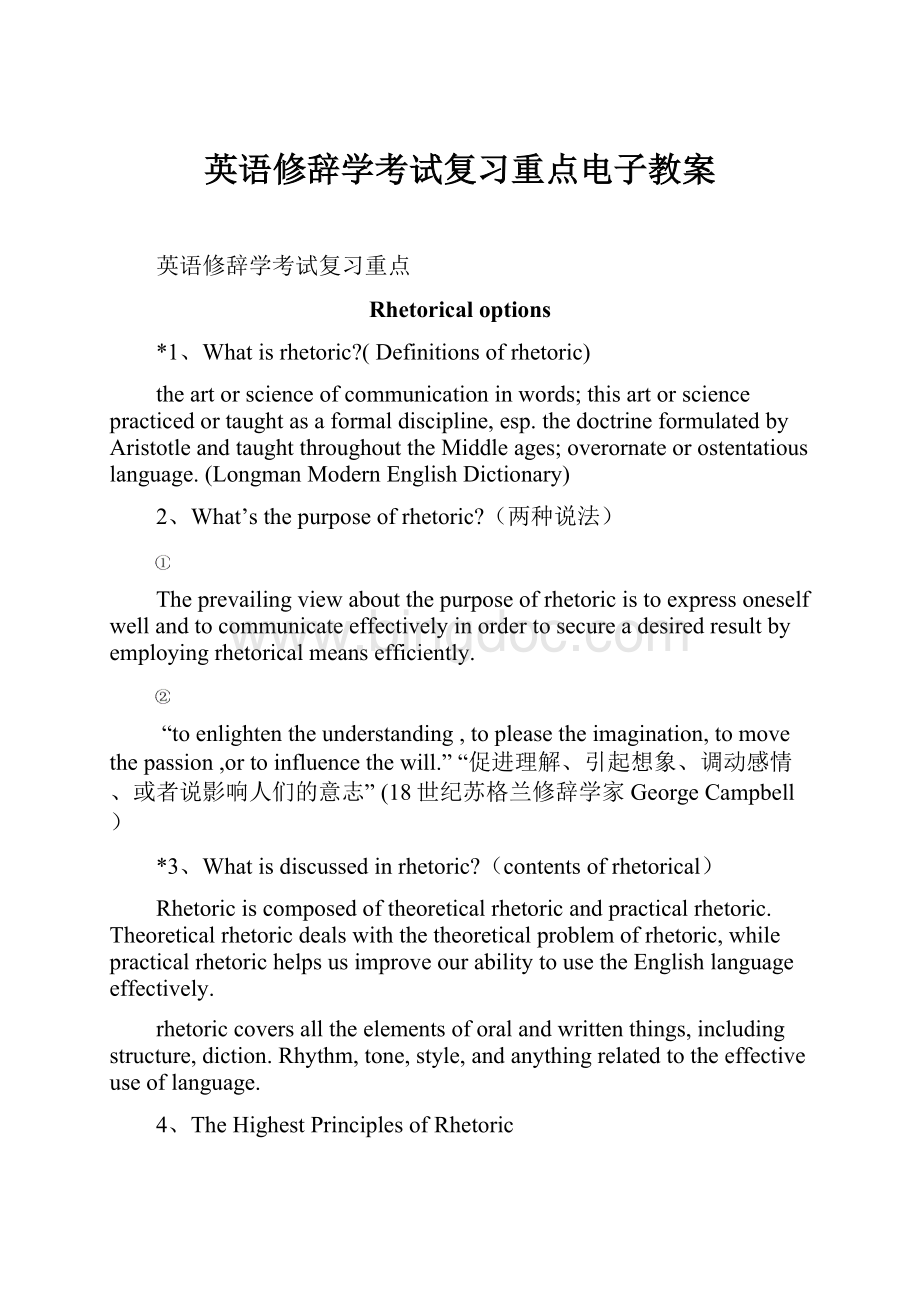英语修辞学考试复习重点电子教案.docx
《英语修辞学考试复习重点电子教案.docx》由会员分享,可在线阅读,更多相关《英语修辞学考试复习重点电子教案.docx(9页珍藏版)》请在冰点文库上搜索。

英语修辞学考试复习重点电子教案
英语修辞学考试复习重点
Rhetoricaloptions
*1、Whatisrhetoric?
(Definitionsofrhetoric)
theartorscienceofcommunicationinwords;thisartorsciencepracticedortaughtasaformaldiscipline,esp.thedoctrineformulatedbyAristotleandtaughtthroughouttheMiddleages;overornateorostentatiouslanguage.(LongmanModernEnglishDictionary)
2、What’sthepurposeofrhetoric?
(两种说法)
Theprevailingviewaboutthepurposeofrhetoricistoexpressoneselfwellandtocommunicateeffectivelyinordertosecureadesiredresultbyemployingrhetoricalmeansefficiently.
“toenlightentheunderstanding,topleasetheimagination,tomovethepassion,ortoinfluencethewill.”“促进理解、引起想象、调动感情、或者说影响人们的意志”(18世纪苏格兰修辞学家GeorgeCampbell)
*3、Whatisdiscussedinrhetoric?
(contentsofrhetorical)
Rhetoriciscomposedoftheoreticalrhetoricandpracticalrhetoric.Theoreticalrhetoricdealswiththetheoreticalproblemofrhetoric,whilepracticalrhetorichelpsusimproveourabilitytousetheEnglishlanguageeffectively.
rhetoriccoversalltheelementsoforalandwrittenthings,includingstructure,diction.Rhythm,tone,style,andanythingrelatedtotheeffectiveuseoflanguage.
4、TheHighestPrinciplesofRhetoric
thehighestprincipleofrhetoricistoadapttospecificsituation,thatis,“adaptability”or“appropriateness”.
Sentence(syntacticdevice)
1、Whatissentence?
Asentenceisagroupofwordswhichexpressesacompletethought.Generally,aneffectivesentencemustpossessfiveessentialqualities:
correctness,clearness,unity,coherenceandemphasis.(正确、清楚、统一、连贯、强调)
2、句子的组成
Asentencemustcontainasubjectandaverb(althoughonemaybeimplied).
words
correctgrammar
meaning
3、句子的分类
SentencesmaybeclassifiedaccordingtoGrammarorRhetoricastomeaningandastoform:
GrammaticalClassificationofSentences
I.Astomeaning:
II.AstoForm:
1.DeclarativeSentence1.SimpleSentence
2.InterrogativeSentence2.CompoundSentence(并列)
3.ImperativeSentence3.ComplexSentence(复合)
4.ExclamatorySentence4.Compound–ComplexSentence
RhetoricalClassificationofSentences
III.AstoArrangement
1.PeriodicSentence(圆周句)left-branchingsentence
2.LooseSentence(松散句)right-branchingsentence
3.BalancedSentence
4、Theshortandlongsentence
Shortsentences,onthewhole,arecharacterizedbytheirbrevity,quicktempoandforce.Theshortsentenceisrelativelysimpleinform,clearingrammaticalrelation,andterseandforcefulinstyle.
Longsentenceisrelativelycomplexinform,fullyexpressiveincapacity,andoftenusedinformalstyletoshowone’scomplicatedmentalityorvariouskindsofrelationshipofdifferentthings.
5、thesimple,compoundandcomplexsentence
ASimplesentencehasonlyoneclausetomakeastatement,andsoitisgoodfordirectnessandclearness.
TheCompoundSentenceconsistsoftwoormoreindependentclauseswhichareofequalstatus,thatis,theclausesareparatactic(parallel;coordinate)inrelationship.
Thecomplexsentencemakesclearthelogicalrelationshipbetweeneventsorideasthroughsubordination.Subordinateclausesarenamedaccordingtotheirfunctions.
Left-branchingsentence(periodicsentence):
*6、thebranchingsentences
Right-branchingsentence(loosesentence):
Left-branchingsentence(periodicsentence):
theperiodicsentencehasitsmainideaattheendofthesentence.supportiveorqualifyinginformationareplacedbeforethemainclauseorassertion.
Right-branchingsentence(loosesentence):
inaloosesentence,themainideaisputatthebeginningofthesentence,andsupportiveorqualifyinginformationcomesfromit.
*7、Balancedsentence:
Whenasentencecontainstowparallelclausessimilarinstructurebutcontrastedinmeaning,itisbalancedsentence.Themainideasareoftenpresentedinparallelphrasesorclauses.
Parallelism排比:
themainfunctionofparallelismistoaddclarityandcoherencetowhatonewishestocommunicate。
Antithesis对比:
antithesisisthedeliberatearrangementofcontrastingwordsorideasinbalancedstructuralformstoachieveforceandemphasis。
Chiasmus回文andantimetabole交叉:
chiasmusisadevicethatconsistsoftwobalancedstatements,thesecondofwhichreversestheorderofthewordsinthefirst,withorwithoutarepetitionofwords。
Forexample:
weeatforlive,notliveforeat。
(herethekeywordsinthefirststatementarerepeated,andreversedinorderinthesecond。
Thisiscalledantimetabole。
)
hewasanangleonthesurface,butatheartaknave。
(herethereisnorepetitionofwords;butthepositionofthenounsandadverbialsarereversed.Thisiscalledchiasmus.)
climax(渐进):
itisextremelyeffectiveinstirringupfeelingsandemotions,orindrivinghomeapoint。
anti-climaxorbathos(突降或渐降):
isadevicethatinvolvesstatingone‘sthoughtsinadescendingorderofsignificanceorintensity,fromstrongtoweak,fromweighttolightorfrivolous。
Itisoftenusedtoridiculeorsatirize。
*9、syntacticschemesofinversion(句子的倒装):
分为grammaticalinversion(语法倒装)和rhetoricalinversion(修辞倒装);一个倒装句能倒回到正常的顺序是修辞倒装,不能倒回的是语法倒装。
Theinversionisnotafactorofcorrectness,buteffectivenessofthatsentence.
Functionofemphasis,vividness,balance,closeconnectionandcompactnessandrhymingverse。
10、thefunctionofsentence:
Thefourbasicsentencefunctionsintheworld'slanguagesincludethedeclarative,interrogative,exclamative,andtheimperative.
Lexicaldevice(word词)
1、themeaningofword:
两种Associativemeaningandconceptualmeaning。
或者七种conceptualmeaning,connotativemeaning,socialmeaning,effectivemeaning,reflectivemeaning,collocatingmeaning,thematicmeaning。
2、词的分类
threelayersofwords:
Thelearned,thecommonandthecolloquial.
Fourtypesofvocabulary:
Readingvocabulary,listeningvocabulary,writingvocabulary,speakingvocabulary。
shortwordsandlongwords;commonwordsorlearnedwords;formal,informalorcolloquialwords;generalorspecificwords;concreteorabstractwords;referentialoremotivewords(意义词或情感词).
3、theprincipleofchoiceofwords:
wordsforclearness
wordsforaccuracy
wordsforeffectiveness
*4、lexicalrepetition
syntacticanaphora(repetitionofbeginningwords首语重复)
5、rhetoricalquestion(设问)
Phoneticdevice(语音学)
1、修辞格
Alliteration(头韵)
Assonance(类韵)
Homeoteleuton(同韵脚)
Onomatopoeia(拟声)
*2、rhythm的组成:
therhythmofEnglishproseinvolvesprosodicfeaturessuchasstress,pitch(tone),volume(loudness),pauseandtempo,apartfromtheusualintonationpatterns。
*Figuresofspeech(修辞格)
1、whatisfiguresofspeech?
(修辞学的定义)
Figureofspeechisan“Ancienttermforanyformofexpressioninwhichthenormaluseoflanguageismanipulated,stressed,oralteredforrhetoricaleffect”(P.H.Matthews).
2、functionsoffigureofspeech(四大功能)
Figuresofspeecharedevicestomakeourlanguagefigurative;theylendforcetoanidea,heighteneffectofexpression,orcreatesuggestiveimagery。
3、Figuresofspeech大体分为三类:
音韵修辞格(phonologicalrhetoricaldevices)
词义修辞格(semanticrhetoricaldevices)
句法修辞格(syntacticalrhetoricaldevices)
音韵修辞格(phonologicalrhetoricaldevices)是利用词语的语音特点创造出来的修辞手法。
它主要包括onomatopoeia,alliteration,homeoteleuton(谐缀格),assonanceandconsonance.
词义修辞格(semanticrhetoricaldevices)词义修辞格主要借助语义的联想和语言的变化等特点创造出来的修辞手法。
它们主要包括simile,metaphor,allusion,metonymy,transferredepithet,personification,hyperbole,irony,euphemism,pun,oxymoron,zeugma,contrast等。
句法修辞格(syntacticalrhetoricaldevices)句子结构上的修辞格主要是指通过句子结构的均衡布局或是突出重点创造出来的修辞手法。
这类辞格主要包括repetition,rhetoricalquestion,antithesis,apostrophe等。
它们与汉语中的反复、设问、对偶、倒装基本相同。
另外一种分类,分为相似修辞格(4种)simile,metaphor,analogy,personification。
相反修辞格opposition和相关修辞格(association)。
*Therearemanykindsoffigureofspeechandtheycanbedividedintomanygroups,suchas:
figuresofsimilarity,figuresofrelationship,figuresofopposition,figuresofemphasis,figuresofsoundandsoon.
*Simile明喻:
Asimileisafigureofspeechwhichmakesacomparisonbetweentwounlikeelementshavingatleastonequalityorcharacteristicincommon。
Wordslikeas,so,like。
组成要素:
comparingwords,subject,reference,ground。
功能:
similehavethreemainuses:
descriptive,illustrativeandilluminative。
例子:
herlockswereyellowasgold。
Metaphor暗喻:
ametaphormakesanimpliedcomparisonbetweentwounlikeelements。
功能:
threemainuses:
descriptive,illustrativeandilluminative。
例子:
jimwasafox。
*Analogy类比:
acomparisonoftwothingsbasedontheirbeingalikeinsomeway。
Analogyischieflyusedforthepurposeofpersuasionorfortheexplanationorexpositionofanidea。
只有三种形式:
AistoBasCistoD
AistoBwhatCistoD
justasAandBsoCandD
Personification拟人:
isafigureofspeechthatgiveshumanformorfeelingstoanimal,orlifeandpersonalattributes
Metonymy借代
Synecdoche提喻
Antonomasia换称
Syllepsis一语双叙
Zeugma轭式搭配
Paradox反论
Oxymoron矛盾修饰法
Hyperbole夸张
Understatement低调陈述
Euphemism委婉
*Irony反讽:
ironyisafigureofspeechthatachievesemphasisbysayingtheoppositeofwhatismeant,theintendedmeaningofthewordsbeingtheoppositeoftheirusualsense。
*Innuendo暗讽:
amildformofirony,hintinginaratherroundaboutwayatsomethingdisparagingoruncomplimentarytothepersonorsubjectmentioned。
*Sarcasm反语:
sarcasmisanintensityformofirony,itattacksinatauntingandbittermanner,anditsaimistodisparage,ridiculeandwoundthefeelingofthesubjectattacked。
Transferredepithet转移修饰法
Punning双关
*Allusion典故:
Anallusionisafigureofspeechthatmakesareferenceto,orrepresentationof,aplace,event,literarywork,myth,orworkofart,eitherdirectlyorbyimplication.
功能:
Itisoftenemployedtoreinforcetheemotionortheideasofone’sownworkwiththeemotionorideasofanotherwork.
例子:
Goldilo